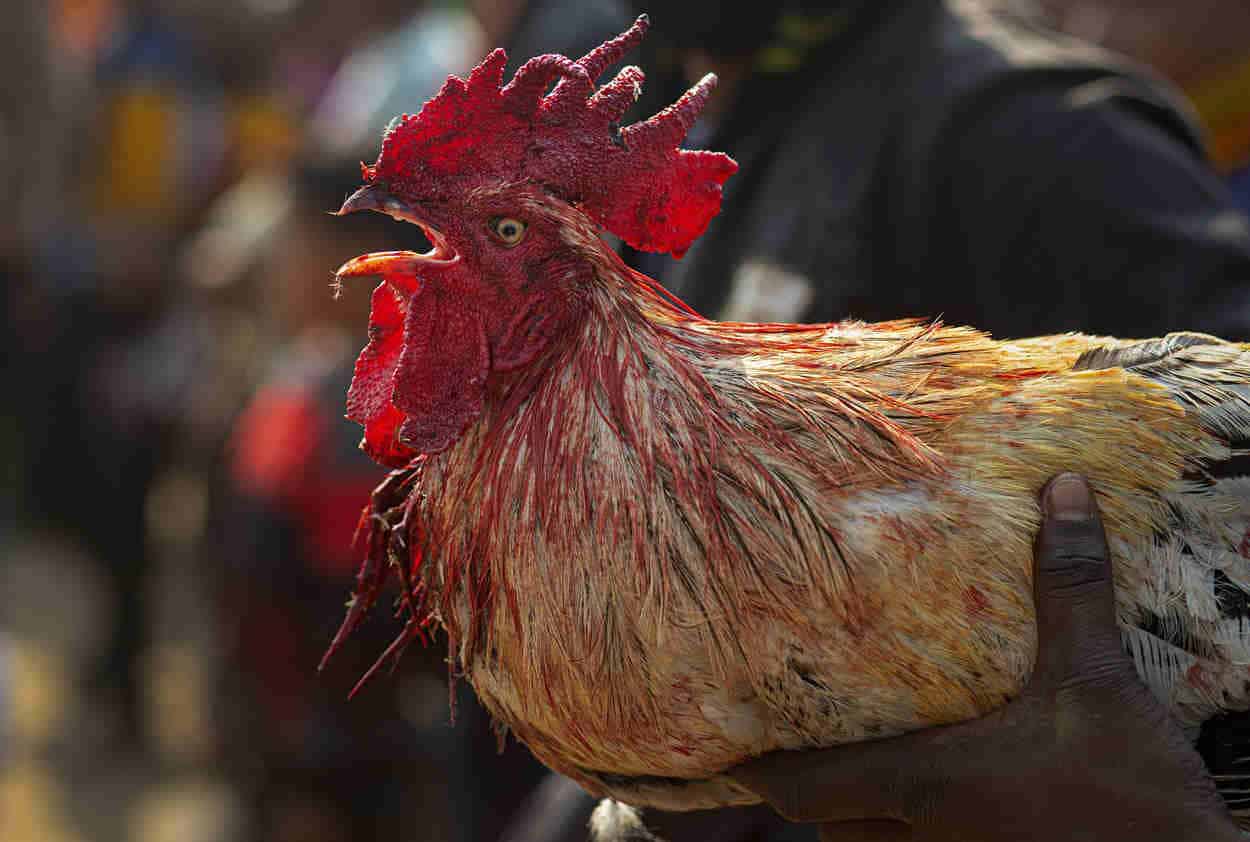Heat stress is one of the worst things a poultry farmer could encounter. It reduces the productivity of your chickens and increases their mortality rate. Hot weather is now even more of a problem nowadays, considering recent heat waves.
Fortunately, you can do a lot to create a conducive environment for your feathered friends. And, some breeds are more tolerant to heat-related issues due to their physique.
Read on and learn how to identify, prevent, and manage heat stress in your flock. Find out ways to cool the coop and strategies for nutrition and hydration. Keep your chicken content when the summer sun blazes. Let’s get cluckin’.
Identifying Heat Stress in Chickens
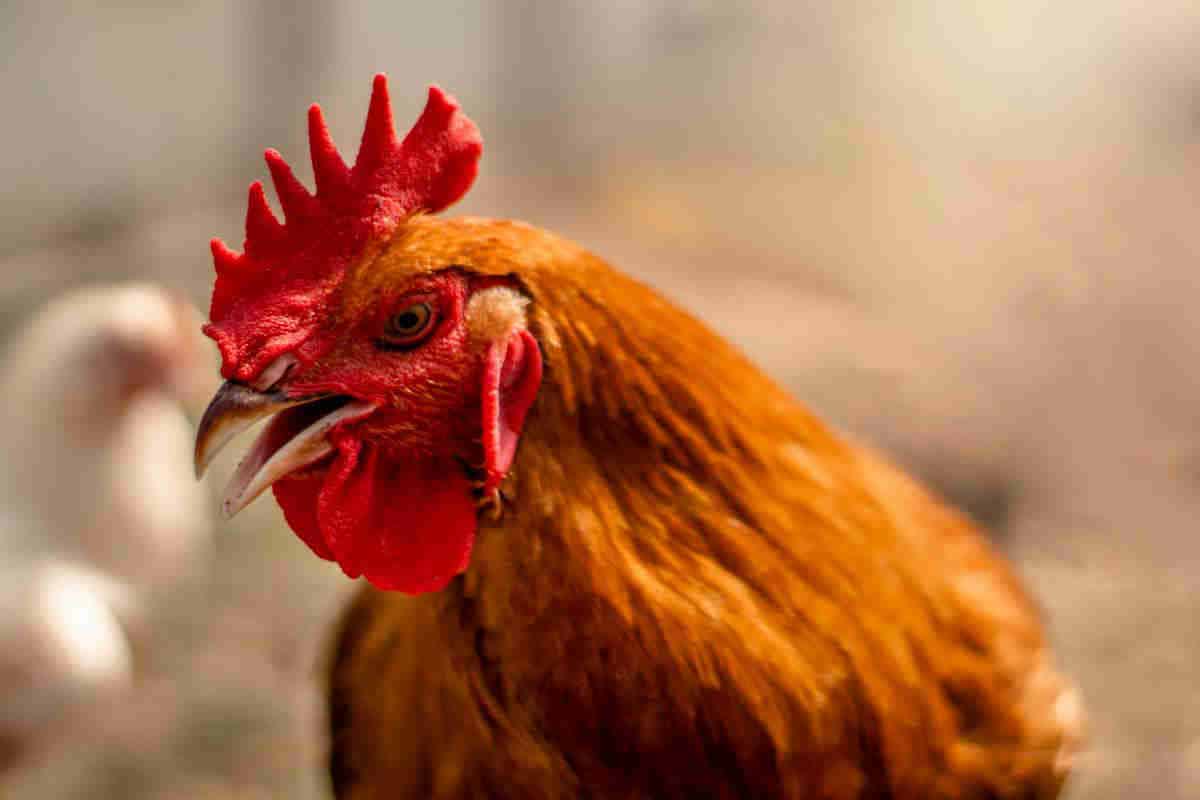
Chickens’ body temperature hovers at around 106℉ (41℃). Because birds don’t have sweat glands, they try to cool down in different ways. When feeling the heat, chickens may pant, fluff their feathers, isolate themselves, or seek shade.
Most chickens can tolerate thermal readings of up to 90℉ (32℃). But, if temperatures are too high for extended periods, your chicken will show symptoms of heat stress.
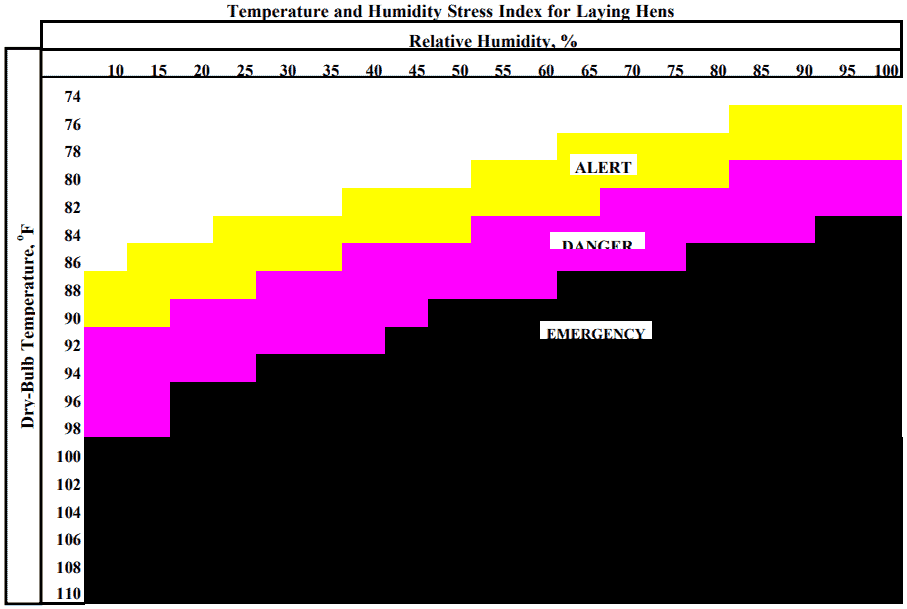
Physical Signs of Heat Stress
Common indicators of heat stress in chickens are:
- Open mouth, panting rapidly.
- Holding wings away from the body.
- Pale combs and wattles.
- Loss of feathers or having ruffled feathers.
- Diminished egg production/quality.
- Drooping and looking lethargic.
- Having reduced appetite accompanied by increased water intake.
- Diarrhea or bloody droppings.
- Fainting, seizures, or sudden death.
Behavioral Changes Indicating Heat Stress
Heat-stressed chickens exhibit the following characteristics when they need to cool down:
- Seek shade or cooler areas.
- Reduced level of usual activity.
- Move less, looking lethargic.
- Isolate themselves from other fowls that are also hot.
- Squawking or making distress noises.
- Being irritable or aggressive.
Factors That Lead to Heat Stress
Are you ready to have your daily dose of existential threat? We’ve heard that the age of global boiling, not warming, is upon us.
Furthermore, extreme weather affects broilers and layers even more. We’ve created these breeds to be meat and egg machines. Free-range chickens on the other hand have adapted more to their natural environment.
It’s wise to keep a close eye on your flock during heatwaves. Here are factors that lead to heat stress in chickens:
Environment: Temperature and Humidity Levels
High humidity makes it harder for chickens to cool down by panting. Panting is akin to losing heat through evaporative cooling. High humidity decreases thermal transfer in the lungs, which increases poultry’s core temperature.
Aside from a thermometer for temperature, get a hygrometer too to ensure the humidity is ideal. Relative humidity (RH) that’s higher than 75% is detrimental for chickens in hot weather.
| Temperature (°F) | Relative Humidity (%) | Chicken’s Reaction |
|---|---|---|
| 60-70 | 20-40 | Comfortable. |
| 60-70 | 50-70 | Monitor ventilation. |
| 70-80 | 20-40 | Comfortable. |
| 70-80 | 50-70 | Slight stress. |
| 80-90 | 20-40 | Mild stress. |
| 80-90 | 50-70 | Moderate stress. |
| 90-100 | 20-40 | High stress. |
| 90-100 | 50-70 | Severe stress. |
| 100+ | 20-40 | Severe stress. |
| 100+ | 50-70 | Critical. |
Housing and Infrastructure Considerations
The design of your chicken coop significantly impacts the temperature inside. Factor in the size, orientation, insulation, ventilation, and shading when making it to keep high heat at bay.
A poorly designed or overcrowded coop can trap warmth and moisture. This creates a stuffy and humid environment for your chickens.
Proper insulation maintains a more stable internal temperature. It reduces the impact of external weather conditions.
Chicken Breed Susceptibility To Heat Stress
Some chicken breeds are more tolerant due to their smaller size, lighter color, less feathering, and larger combs. Some breeds have even better physiology such as enhanced respiratory and cardiovascular systems to cope.
It’s wise to consider the breed you want to raise and adjust accordingly.
Breeds like Leghorns, Rhode Island Reds, and Minorcas which originated from tropical and subtropical regions are more heat tolerant.
Breeds like Wyandottes and Brahmas that hail from cold terrains can’t handle the heat. On the other hand, they fare well in cool regions like far North America and Canada.
Here’s a neat video showing different breeds and where they came from. You can see how they’re structured and intuitively tell they spring from certain climatic zones due to their physique.
Preparing the Coop for Hot Weather
Here are adjustments and improvements you can do to your coop or yard for a comfortable environment for your chickens:
Importance and Methods of Coop Insulation
Proper insulation makes a world of difference in extreme weather conditions. Keep the heat out in the coop during summer and vice versa over winter.
Add more insulation using wood shavings, straw, hay, cardboard, foam boards, reflective foil/barriers, or spray foam.
The amount of insulation required to act as a barrier against heat transfer depends on the weather and coop structure. Add vents or windows to the walls to allow for more air circulation and moisture evaporation when needed.
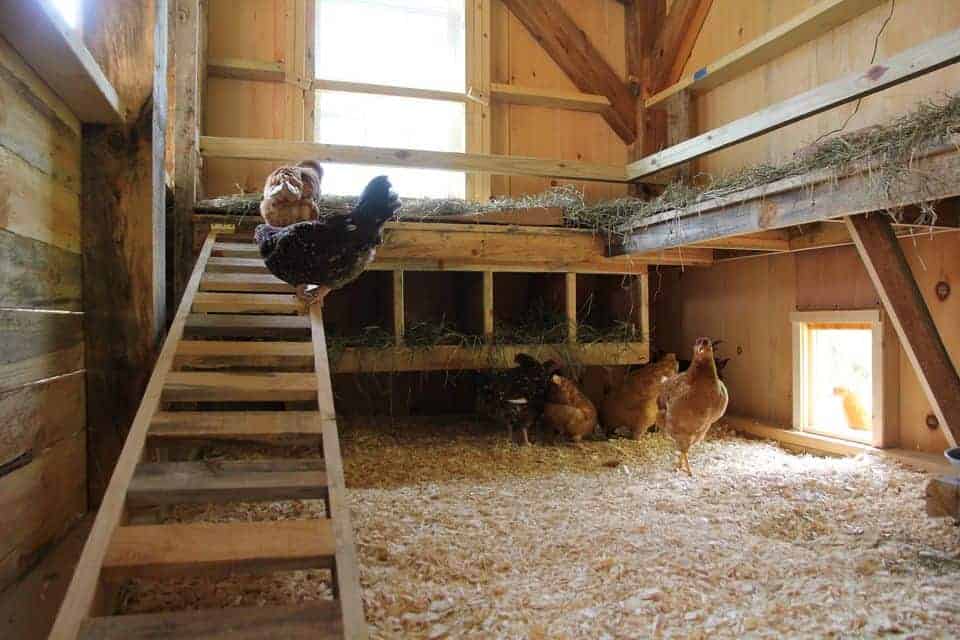
The Role of Coop Location and Orientation
You must consider those scorching summer days when building a coop.
Ideally, build in a shady area that’s protected from direct sunlight. Structures like trees, fences, and buildings can help provide shade. Even so, you should ensure there’s enough space around for airflow and ventilation.
When constructing the coop, ensure the longest elevations of the walls face the north/south direction. This orientation reduces the amount of heat coming in through the barrier.
Implementing Cooling Systems in the Coop
There are several ways you can lower the temperature in your coop by implementing systems like:
- Use electric or battery-powered fans to create a breeze that removes excess heat from the coop.
- Ice bottles are an inexpensive solution to cool down the enclosure. Wrap them up using a cloth for your chicken to cuddle with when it’s too hot.
- Misters spray cool water droplets into the air, but they increase humidity, which should be dealt with.
- Evaporative cooling is the use of water and air to create a revitalizing effect. For example, hanging drapes inside water precipitate evaporation, adding more cooling.
Combining several techniques can be a lifesaver for your chickens when the heat becomes unbearable.
Nutritional and Hydration Management
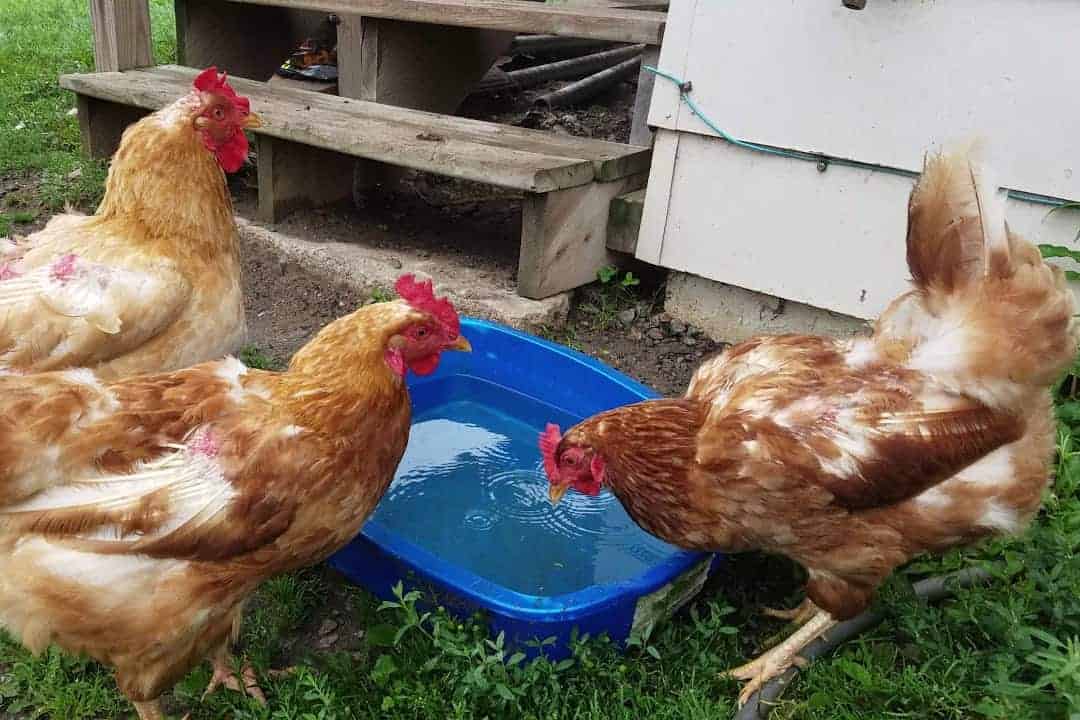
Food and water can also help your chicken cope with the heat. Here are several tips for what you can do when providing feed and water:
Hydration Strategies and Water Management Importance
Water helps regulate body temperature, digestion, metabolism, circulation, and excretion. For fowls, water lost due to panting, diarrhea, or reduced intake can lead to dehydration. In turn, this often worsens heat stress, causing serious health problems.
Use these quick strategies when providing water during hot days:
- Provide many water sources, so the chickens don’t crowd together fighting over it.
- Use large and wide containers that aren’t prone to spillage. This reduces the chances of excess humidity while allowing for more evaporative cooling.
- Change the drink frequently and add ice cubes or frozen water bottles to make it more refreshing for your chickens.
- Avoid metal containers for water because they heat up fast in sunlight.
- Provide electrolytes to the drink, considering it helps chickens cope with heat stress better.
Nutritional Considerations for Heat Stress Prevention
Feed intake and quality can affect the health and productivity of chickens more so during heat stress. Feed intake typically decreases due to excessive water consumption or reduced activity in hot weather.
Some nutritional considerations and feeding strategies utilized to reduce heat stress are:
- Adjust the time and frequency of feeding—feed more in the morning and late in the evening when it’s cooler.
- Use pellets or crumbles because chickens use less effort picking that up compared to mash or whole grains.
- Use high energy, low protein feed because it produces less body heat during digestion.
- Add supplements and additives that enhance the nutritional value or quality of your feed.
- Provide fresh fruit and vegetables because they are rich in water, vitamins, minerals, and antioxidants. These ingredients help hydrate and nourish your chicken.
The Use of Electrolytes and Supplements
Electrolytes help replenish nutrients and minerals lost in extreme weather and stressful conditions.
Minerals and supplements help balance fluid and pH levels in your chicken’s body, as well as support kidney function. In turn, this boosts their immunity and health when they are most vulnerable.
You can get these nutrients online, from a local agro vet, or make them using ingredients readily available in your kitchen. Follow the recommended dosage when introducing electrolytes into your chicken’s diet.
Natural Cooling Methods and Artificial Solutions
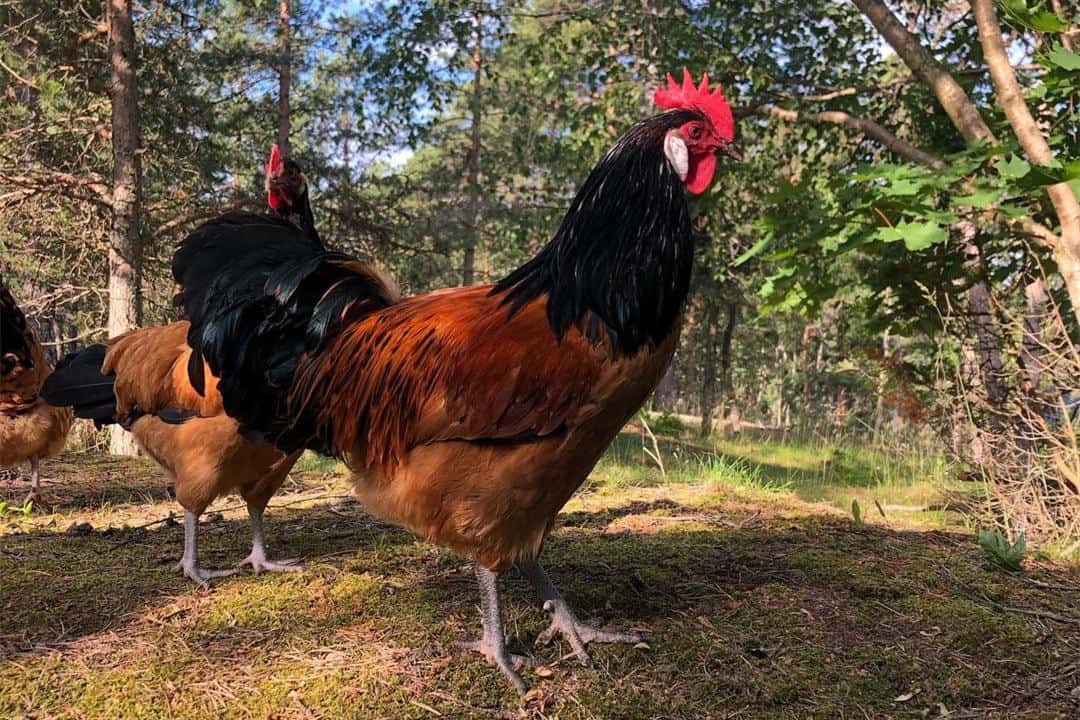
Below, we’ll look at techniques and devices (natural/man-made) you can put in place to create a cool environment:
Utilizing Shade Structures and Trees
A shade in your chicken run or yard gives your birds much-needed respite from the sun. Trees, tents, canopies, or roofs made out of wood, metal, or plastic can be just what you need.
Depending on what works for you, build a shade structure that is fixed or movable. Trees also beautify the environment, even though they take a considerable time to grow.
Dust Baths and Misting Techniques
Chickens love dust baths. These are areas where poultry roll and rub their bodies in dry soil, sand, ash, or other fine material. They do this to remove excess oil, dirt, parasites, and dead skin.
Dust baths also help chickens fluff their feathers, creating air pockets that improve insulation from heat and cold.
Misting helps chickens lower their body temperature. It precipitates the evaporation of water from their skin and respiratory tract. Mist also helps chicken moisten their skin and prevent dryness or cracking during the hot season.
Managing Heat Stress in Free-Range Chickens

There’s less control over the environment when raising chicken in a free-range system. Fortunately, there are measures you can put in place to help them cope when heat waves come around.
Ensure there’s adequate shade and shelter, using natural or artificial structures where the birds can retreat to. You can also provide a coop or hut for your chickens to find refuge in when it’s too hot. The cooling area should be spacious, ventilated, and insulated.
Provide many water sources and feed stations. Also, change the drink regularly if it’s warm or add ice cubes or frozen water bottles to the water sources. Remember to provide electrolytes and supplements to the feed or drink.
Choose and raise heat-resistant free-range chicken breeds if you live in a region that gets too hot. Look at what other farmers succeed with to get a better picture of what works.
Change the feeding schedule to feed in the evening and early morning when it’s cooler.
Handling Emergencies Related to Heat Stress
Life-threatening symptoms like difficulty breathing, severe lethargy, fainting, or seizures due to heat stress in chickens are your cue to act fast. Here are first-aid procedures you can undertake to save their lives:
- Move affected fowls to a shaded, ventilated, cool, and quiet place.
- Using cool (not cold) water, wet the chickens’ under wings, comb, wattles, and feet.
- Place a fan or evaporative cooler in front of the birds.
- Provide cool water with electrolytes and supplements for recovery, but don’t force-feed.
- After, consult a veterinarian if symptoms persist or if you have any questions or concerns.
Heat Stress, Egg Production, and Growth
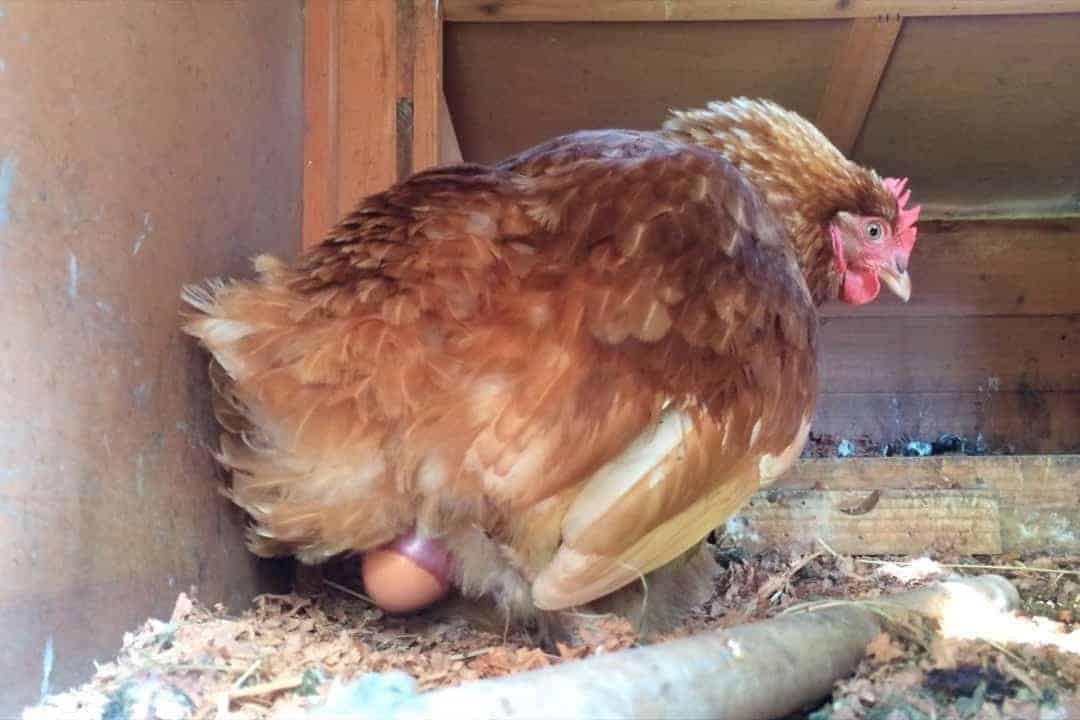
Chicken lay the most eggs during summer. However, extreme heat temporarily reduces their output and can even make them stop laying eggs altogether.
Egg laying and chick growth are processes that use a lot of energy. Heat stress affects the fowl’s hormonal balance, ovulation cycle, and egg formation.
Reduced activity levels also decrease feed intake. All these factors contribute to less nutrient use and egg quality. Deficient calcium absorption generally leads to reduced egg size and weak shells.
Conclusion
The onus is on you, the chicken keeper, to safeguard your feathered friends’ well-being during scorching hot days. Now you know how to identify, prevent, and manage the condition to maintain a healthy and productive flock.
We’ve covered everything from providing shade, proper ventilation, managing hydration, and every little effort that counts in ensuring your chickens remain cool and content. Remember, prevention is key.
Prepare your flock when faced with “global boiling.” Using tips from this guide, spread your wings and build a coop or environment that’s primed for hot weather. In the end, toast to a glass of cool water because your poultry is comfortable, healthy, and happy in the heat.

Joseph Hudson has been raising chickens for over 15 years. In 2018, he completed the Agriculture & Natural Resources program at Mt. San Antonio College. He currently raises over 1400 chickens on his 7.5-hectare farm. He keeps sharing his experience on raising healthy and happy chickens on Chicken Scratch The Foundry.
